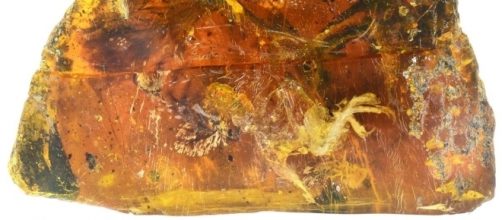Ninety-nine million years ago, a hatchling no more than a few days old was swallowed in amber, according to National Geographic. We do not know the exact circumstances that led to the bird’s predicament. Nevertheless, the bird remained there, frozen, through the mass extinction, the melting of the glaciers and the industrial revolution, until it became a fossil and was seen again by a CT scanner in China.
The bird, which belonged to the major group enantiornithines, lived during the Cretaceous period known for Tyrannosaurus rex. The period lasted from 145.5 to 65.5 million years ago, 20 million years before the dinosaurs went extinct.
The fossil has been nicknamed ‘Belone’ by researchers after an amber-colored skylark.
Most completed amber fossil foundThe hatchling belonged to a major group of birds, which went extinct along with dinosaurs 65 million years ago https://t.co/5SzF5DKFFH
— National Geographic (@NatGeo) June 9, 2017
The hatchling belonged to a major group of birds, which went extinct along with dinosaurs 65 million years ago https://t.co/5SzF5DKFFH
— National Geographic (@NatGeo) June 9, 2017
The 3-inch specimen, is the most complete fossil found to date in Burmese amber. Most of its skull and neck are preserved, along with part of a wing and hindlimb, and the soft tissue of a tail, according to Gondwana Research.
The fossil contains plumage that can be seen with the naked eye as well as feather microstructure and color.
How ancient birds differed from now
Because the bird was so young when it died, it gives us clues about the growth stages of enantiornithines.
In past findings of these ancient birds, their feathers suggested their flight patterns were strikingly similar to modern birds, National Geographic reports.
The bird has a set of flight feathers, but is lacking feathers on the rest of its body, much like theropod dinosaurs. The fact that they flew in early juvenile stages suggests that they were less dependent on their parents than most modern birds.
We now know that most dinosaurs had feathers and that one characteristic of dinosaurs that set them apart from the rest of the animal kingdom was the presence of a wishbone. Therapods had wishbones, which is basically the fusion of two clavicles, comparable to our collarbone, according to National Audubon Society. These dinosaurs stood upright and ran on two legs.
How do they know how old the bird was?
They can tell the age of the bird based on its molting pattern. A CT scan shows the distribution of feathers, which also helps identify the species. Previous fossilized remains of individual feathers found in amber from this era provide more evidence of the bird’s age.
Who found it?
According to National Geographic, the fossil was purchased in Myanmar by Guang Chen, director of the Hupoge Amber Museum in Tengchong City, China. He heard about an amber sample with a “lizard claw”, and went to retrieve it. Chen brought it to Lida Xing of the China University of Geosciences, who identified it as enantiornithine foot.
This exciting Discovery adds to the incredible collection of ancient fossils found by man.
It reminds us that the planet we live on now used to be a very different place, with much larger creatures. There is no doubt these remains are intriguing.
‘Belone’ will be on display at the Shanghai Museum of Natural History until the end of July.


